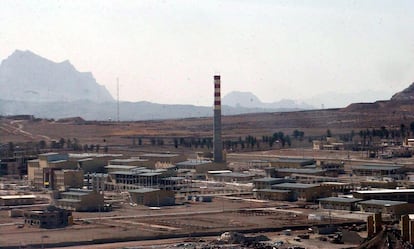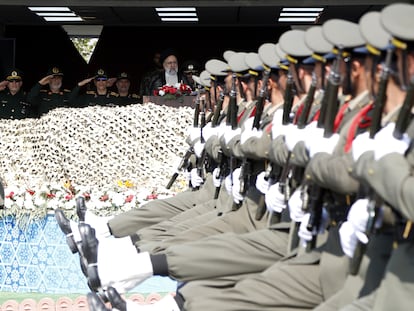Israel launches limited retaliatory strike against Iran
The target of the operation, a response to the Iranian attack last weekend, was Isfahan, where the heart of the country’s nuclear program is located. The International Atomic Energy Agency confirmed that no nuclear facilities were damaged. Tehran says it has shot down three drones and is downplaying the situation

Israel attacked targets in Iran early on Friday, five days after Iran launched more than 300 drones and missiles against Israeli territory in an offensive that caused no deaths and hardly any material damage. Information about the scope and nature of the attack is unclear at the moment, although it appears to be limited. Tehran claims to have destroyed three drones in Isfahan province, the heart of Iran’s nuclear program, after activating its defense systems. The U.N.’s International Atomic Energy Agency (IAEA) has confirmed that no Iranian nuclear facilities were damaged.
A senior Iranian official quoted by Reuters said that Tehran — which had warned that it would respond to the slightest attack on its territory — does not plan to retaliate immediately because it is not clear who is behind the attack. Israel, as usual, has remained silent. Initial reports point to a moderate retaliation, following international calls for restraint.
The United States did not participate in the operation. According to Reuters, Israel had warned Washington earlier on Thursday that a strike was imminent. Sources quoted by U.S. and local media report the use of missiles in the offensive, which Tehran denies.
“The foreign source of the incident has not been confirmed,” the Iranian official told Reuters. “We have not received any external attack, and the discussion leans more towards infiltration [operation from within] than attack.” The official Iranian media are playing down the importance of the Israeli attack, a response to the also calculated offensive launched by Tehran last Saturday night.
There are no reports of casualties or material damage, and no major explosions were felt, according to Iranian media. The spokesperson for Iran’s National Cyberspace Center, Hossein Dalirian, stated in a message on X (formerly Twitter) that his country had shot down quadcopters, small unmanned devices with four propellers to which an explosive charge can be added. Israel has used this device in the past to attack Iran, as was the case in 2021 and last year. Isfahan was also targeted. The official Iranian television reported that several drones had been shot down.
Israel’s silence
Israel rarely acknowledges its operations abroad, at least not immediately. It remains to be seen whether any leaders will hint that Israel was behind the attack, without expressly taking responsibility. Only the Minister of National Security, the ultra-right-wing Itamar Ben Gvir, has spoken out. In a message on X (formerly Twitter) he expressed his disappointment that the attack was not more powerful. His ministry controls the police, but Ben Gvir is not part of the war cabinet, which makes military decisions.
The Iranian new agency Fars had previously reported that Israeli devices had hit near Isfahan airport and that anti-aircraft systems had been activated. Iran’s national airspace was temporarily closed and has now been restored, according to the Airports and Air Navigation Company of Iran, quoted by the state news agency.
This area, in the center of the country and about 250 miles south of the capital, is home to military installations, defense system factories and, above all, nuclear system facilities such as Natanz, from where Tehran announced in 2007 that it had joined to the club of countries capable of producing nuclear fuel on an industrial scale. The Isfahan Nuclear Technology Center (INTC) is the largest nuclear research complex in Iran and employs approximately 3,000 scientists. The United States and Israel suspect that its facilities host a secret research program to produce atomic weapons, an accusation that Tehran denies. Iran maintains that its nuclear program is exclusively for civilian purposes. This site has previously been the target of attacks from Israel.
The offensive was not limited to Iran. The official Syrian news agency Sana reported, citing military sources, an early morning attack on the country’s air defense systems that caused only material damage. Tehran supports the regime of Bashar al-Assad in the civil war in Syria, and its allied militias have become strong.
Military response
Throughout the week, Israel had announced in different forums that the Iranian regime’s unprecedented offensive against its territory required a military response. Iran’s decision to launch hundreds of drones and missiles over different Israeli regions escalated the risk of a regional war breaking out. Tehran’s offensive was a response to the bombing carried out by Israel on the Iranian consulate in Damascus (Syria) on April 1, in which 16 people were killed, including seven members of the Revolutionary Guards. One of the victims was General Mohamed Reza Zahedi, the head of the Al Quds force in Lebanon, the regional branch of the Iranian force.

Israel has been calibrating the form and scale of its response for several days. Amid the threats and the war rhetoric of both countries, there has been growing international pressure for the conflict to be contained. The IAEA already expressed its fear that a possible Israeli attack would reach Iran’s nuclear facilities, according to the director general of the institution, Rafael Grossi. The United States on Thursday announced new sanctions against Iran and its drone industry and missile program, in a coordinated move with the United Kingdom, which has taken similar measures. The European Union also announced that it will consider imposing similar measures on Tehran.
Meanwhile, in Gaza, where almost 34,000 Palestinians have been killed since the war began on October 7, Israeli attacks continue, according to the Palestinian agency Wafa. The war began in response to the Hamas massacre on that day, in which 1,200 people were killed in Israeli territory.
Israel announced that it would carry out a ground offensive in Rafah, but while Israeli troops have been moving around the south of the Gaza Strip, the plan remains in the air. The southern city of Rafah, on the border of Egypt, where nearly 1.5 million Gazans hit by the humanitarian crisis are living in overcrowded conditions, is the only one that Israeli troops have not yet invaded. Netanyahu insists that this operation is needed to fulfill the two essential objectives of the war: ending Hamas politically and militarily and bringing back the 133 Israeli hostages (many of whom have died) who still remain captive.
Sign up for our weekly newsletter to get more English-language news coverage from EL PAÍS USA Edition
Tu suscripción se está usando en otro dispositivo
¿Quieres añadir otro usuario a tu suscripción?
Si continúas leyendo en este dispositivo, no se podrá leer en el otro.
FlechaTu suscripción se está usando en otro dispositivo y solo puedes acceder a EL PAÍS desde un dispositivo a la vez.
Si quieres compartir tu cuenta, cambia tu suscripción a la modalidad Premium, así podrás añadir otro usuario. Cada uno accederá con su propia cuenta de email, lo que os permitirá personalizar vuestra experiencia en EL PAÍS.
¿Tienes una suscripción de empresa? Accede aquí para contratar más cuentas.
En el caso de no saber quién está usando tu cuenta, te recomendamos cambiar tu contraseña aquí.
Si decides continuar compartiendo tu cuenta, este mensaje se mostrará en tu dispositivo y en el de la otra persona que está usando tu cuenta de forma indefinida, afectando a tu experiencia de lectura. Puedes consultar aquí los términos y condiciones de la suscripción digital.
More information
Archived In
Últimas noticias
Most viewed
- Reinhard Genzel, Nobel laureate in physics: ‘One-minute videos will never give you the truth’
- Oona Chaplin: ‘I told James Cameron that I was living in a treehouse and starting a permaculture project with a friend’
- Pablo Escobar’s hippos: A serious environmental problem, 40 years on
- Why we lost the habit of sleeping in two segments and how that changed our sense of time
- Charles Dubouloz, mountaineering star, retires at 36 with a farewell tour inspired by Walter Bonatti










































